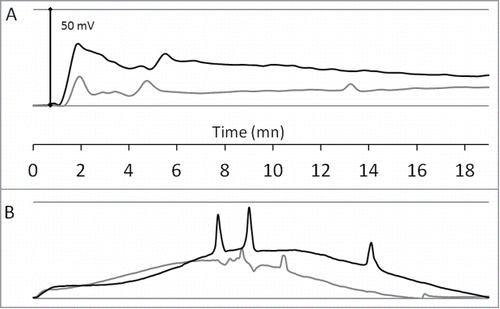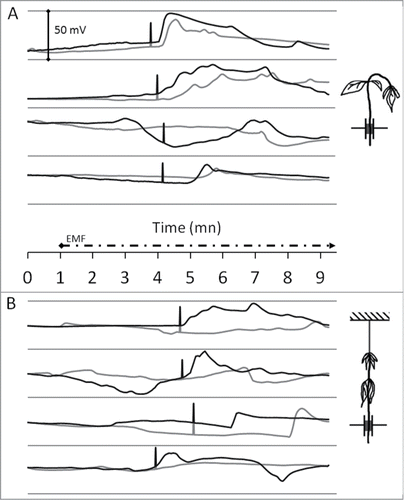Figures & data
Figure 1. Experimental set-up for real-time monitoring of plant temperature and EPV in response to EMF. Top view of the general arrangement (A): Plants (1) were illuminated inside a wide (72 m3) anechoic chamber (2). The EMF was generated by a signal generator (3) connected to an amplifier (4) and emitted by a horn-antenna (5). The EMF was monitored by a field probe (6). Temperature of the plant was monitored by a thermal video camera (7) itself tracked by a security camera (8). The electrical potential monitoring system was shielded inside a small faraday box (9). Output signals from the electrophysiological amplifiers were transmitted to a data acquisition cartridge (10) through BNC shielded cables. An external computer allowed all signals control and monitoring (11). Detailed profile view of the shielded set-up (B): only the upper part (≈ 30 cm) of the plant stem (with leaves) was EMF exposed. The distance plant-antenna was ≈ 50 cm. The small arrow on the plant stem symbolizes the EMF focalizing point (f). The plant was immobilized inside the small Faraday box through a tubular metallic wave-guide (1) by a polystyrene holder. The rest of the plant, the 2 very high impedance amplifiers (2), the extra-thin tungsten measuring electrodes (3) and the reference cells (4) were all protected from the EMF inside the shielding box (5). The 2 measuring electrodes were hand inserted perpendicularly to each other in the plant stem and spaced by 5 to 7 cm. The references cells and the Faraday box were connected to the ground.

Figure 2. Experimental validation of the electrophysiological set-up. The graphs show the monitoring of EPV with 2 tungsten electrodes (up: black-line; down: gray-line) inserted as described in . Data are baseline-adjusted and expressed in millivolt (the plants resting electrical potentials were 200 to 350 mV). Sunflower leaf flaming (A): one upper leaf of a 4-weeks-old plant was flamed for 1 sec at time 0 min. Shading (B): a sunflower plant was exposed to a light-to-dark switch (200 to 0 μmol/m2/s) at time 0 min.

Table 1. Bending time points and temperature thresholds
Figure 3. Sunflower exposition to high-intensity microwave-frequency EMF. Height sunflower plants were exposed to a 2.5 GHz ‑ 1.5 kV/m EMF (dashed timeline). The graphs show the monitoring of EPV with 2 tungsten electrodes (up: black-line; down: gray-line) inserted as described in . Data are baseline-adjusted and expressed in millivolt (the plants resting electrical potentials were 200 to 350 mV). Black bars symbolize the time point of stem or petiole bending. Free apex (A): Four sunflower plants were exposed to EMF as described in . Tied apex (B): To avoid stem bending, the sunflower plants apexes were tied with a non conductive plastic string, before exposure to EMF.

Figure 4. Effect of the radiated energy decrease on the plant response delay. Sunflower plants were exposed to a 2.5 GHz ‑ 1.5 kV/m EMF showing various duty cycles (50 to 5 %). As illustrated on the x-axis, the duty cycle is the percentage of emission during one period. Black squares display the time point of stem bending (followed by EPV).

